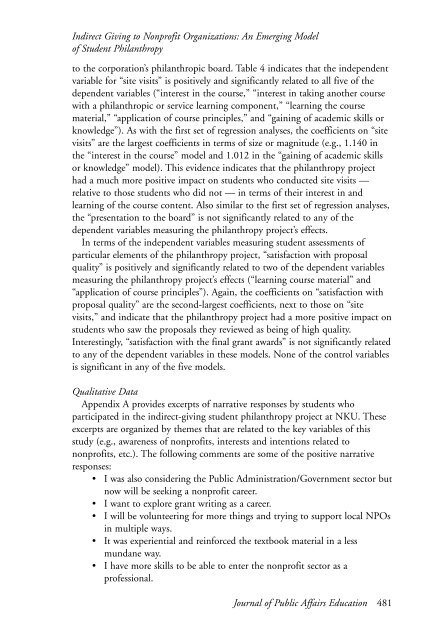JOURNAL OF PUBLIC AFFAIRS EDUCATION - National ...
JOURNAL OF PUBLIC AFFAIRS EDUCATION - National ...
JOURNAL OF PUBLIC AFFAIRS EDUCATION - National ...
You also want an ePaper? Increase the reach of your titles
YUMPU automatically turns print PDFs into web optimized ePapers that Google loves.
Indirect Giving to Nonprofit Organizations: An Emerging Model<br />
of Student Philanthropy<br />
to the corporation’s philanthropic board. Table 4 indicates that the independent<br />
variable for “site visits” is positively and significantly related to all five of the<br />
dependent variables (“interest in the course,” “interest in taking another course<br />
with a philanthropic or service learning component,” “learning the course<br />
material,” “application of course principles,” and “gaining of academic skills or<br />
knowledge”). As with the first set of regression analyses, the coefficients on “site<br />
visits” are the largest coefficients in terms of size or magnitude (e.g., 1.140 in<br />
the “interest in the course” model and 1.012 in the “gaining of academic skills<br />
or knowledge” model). This evidence indicates that the philanthropy project<br />
had a much more positive impact on students who conducted site visits —<br />
relative to those students who did not — in terms of their interest in and<br />
learning of the course content. Also similar to the first set of regression analyses,<br />
the “presentation to the board” is not significantly related to any of the<br />
dependent variables measuring the philanthropy project’s effects.<br />
In terms of the independent variables measuring student assessments of<br />
particular elements of the philanthropy project, “satisfaction with proposal<br />
quality” is positively and significantly related to two of the dependent variables<br />
measuring the philanthropy project’s effects (“learning course material” and<br />
“application of course principles”). Again, the coefficients on “satisfaction with<br />
proposal quality” are the second-largest coefficients, next to those on “site<br />
visits,” and indicate that the philanthropy project had a more positive impact on<br />
students who saw the proposals they reviewed as being of high quality.<br />
Interestingly, “satisfaction with the final grant awards” is not significantly related<br />
to any of the dependent variables in these models. None of the control variables<br />
is significant in any of the five models.<br />
Qualitative Data<br />
Appendix A provides excerpts of narrative responses by students who<br />
participated in the indirect-giving student philanthropy project at NKU. These<br />
excerpts are organized by themes that are related to the key variables of this<br />
study (e.g., awareness of nonprofits, interests and intentions related to<br />
nonprofits, etc.). The following comments are some of the positive narrative<br />
responses:<br />
• I was also considering the Public Administration/Government sector but<br />
now will be seeking a nonprofit career.<br />
• I want to explore grant writing as a career.<br />
• I will be volunteering for more things and trying to support local NPOs<br />
in multiple ways.<br />
• It was experiential and reinforced the textbook material in a less<br />
mundane way.<br />
• I have more skills to be able to enter the nonprofit sector as a<br />
professional.<br />
Journal of Public Affairs Education 481

















